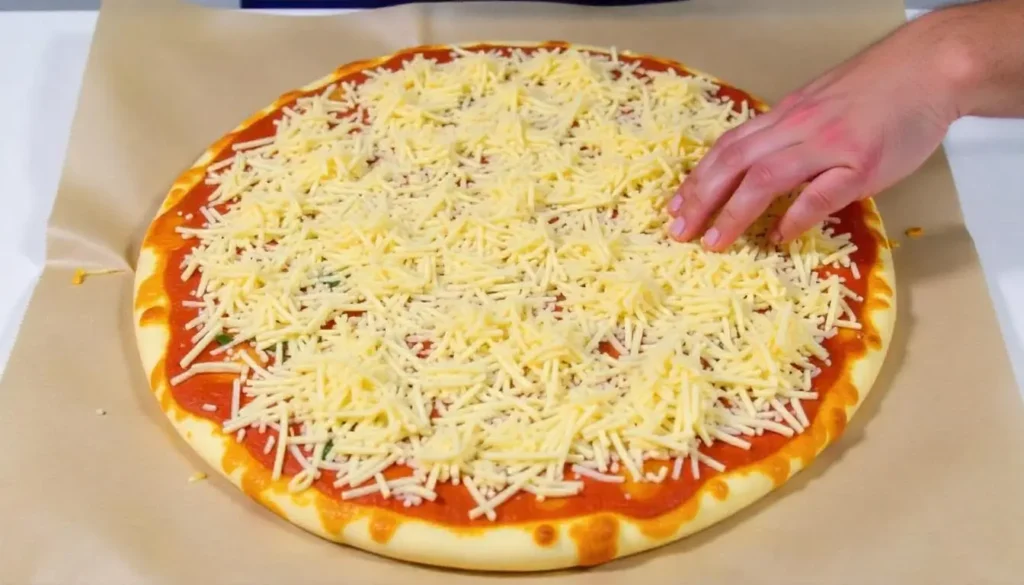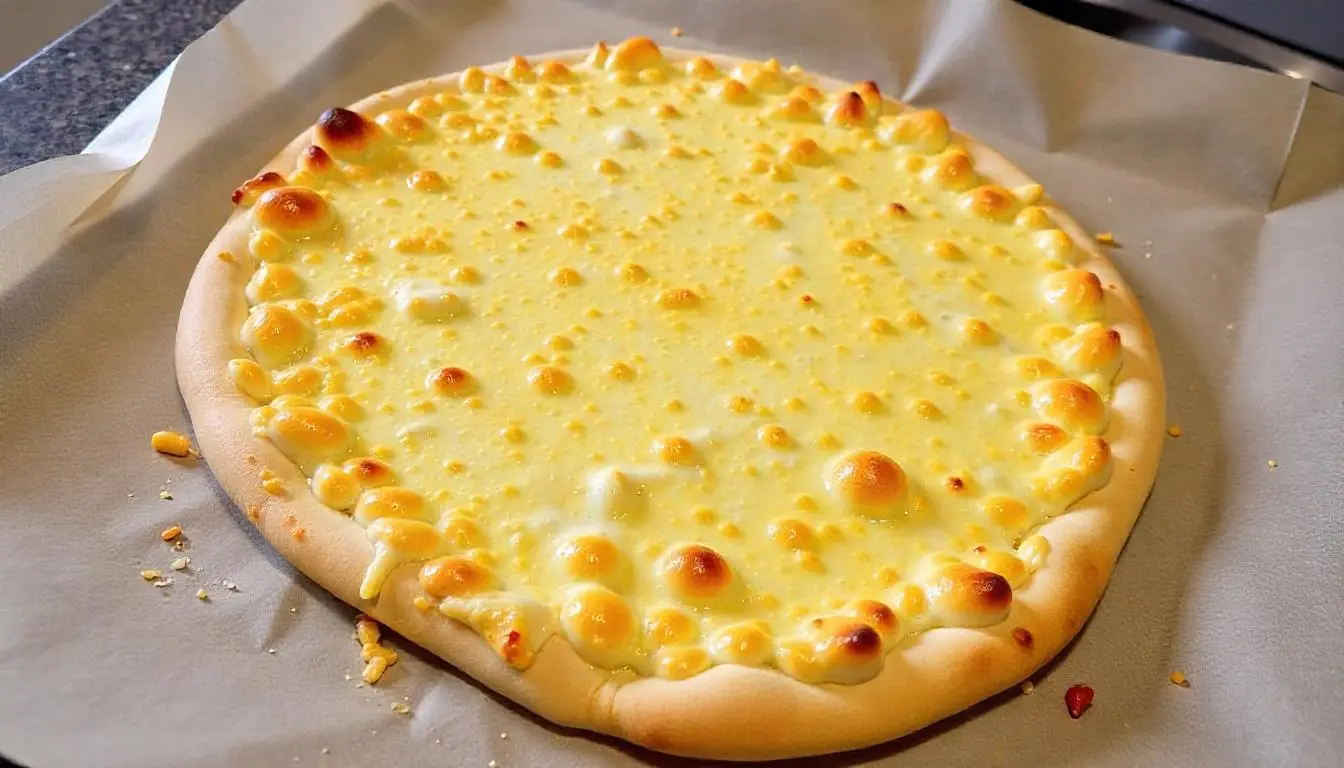Who doesn’t love pizza? But if you’re looking for a healthier, high-protein alternative to traditional pizza dough, you’ve come to the right place! This cottage cheese pizza crust recipe is the perfect option for those following a low-carb, keto, or gluten-free diet while still craving a delicious, crispy pizza.
Unlike regular pizza dough that relies on flour and yeast, this cheese-based crust is packed with protein, healthy fats, and a rich, cheesy flavor. The addition of cottage cheese makes it soft on the inside while keeping the edges perfectly crisp. Plus, it’s easy to make, requiring just a few simple ingredients like eggs, almond flour, and mozzarella cheese.
In this guide, we’ll walk you through:
✅ Why cottage cheese makes the perfect pizza crust alternative
✅ A simple step-by-step recipe with easy-to-find ingredients
✅ Tips to achieve a crispy, golden crust every time
✅ Delicious topping ideas to customize your pizza
Whether you’re on a fitness journey, looking for a quick homemade pizza fix, or just curious about healthy pizza alternatives, this recipe will become your go-to! Let’s dive in and make the perfect cottage cheese pizza crust from scratch. 🍕💛
Table of Contents
Why Choose Cottage Cheese Pizza Crust?
High-Protein and Low-Carb Alternative
Cottage cheese pizza crust is a game-changer if you’re looking to enjoy pizza while sticking to a high-protein, low-carb diet. Unlike traditional pizza dough, which is loaded with refined flour and carbohydrates, this cheese-based crust is packed with protein from cottage cheese, eggs, and mozzarella.
- High-Protein Content: Cottage cheese is naturally rich in protein, supporting muscle growth, keeping you full longer, and preventing cravings.
- Low in Carbs: Unlike regular pizza crust, which can have 30-40g of carbs per slice, this recipe keeps carbs low, making it ideal for keto and low-carb lifestyles.
- Balanced Nutrition: With the perfect mix of protein, healthy fats, and fewer carbs, this crust provides long-lasting energy without blood sugar spikes.
Gluten-Free and Keto-Friendly Benefits
For those with gluten intolerance, celiac disease, or anyone following a gluten-free diet, finding the right pizza crust can be tricky. Luckily, this cottage cheese pizza crust is 100% gluten-free, making it a perfect alternative for those avoiding wheat-based dough.
- No Refined Flour: Traditional pizza crusts are made with wheat flour, which contains gluten. This recipe eliminates gluten while still providing structure and texture.
- Keto-Friendly: A typical pizza crust is packed with carbs, but this version fits perfectly into a keto meal plan, keeping net carbs low and healthy fats high.
- Better Digestion: Many people experience bloating or digestive discomfort from gluten-heavy foods. A cheese-based crust is easier on the stomach while still being satisfying.
This means you can enjoy a delicious pizza night without the guilt or digestive issues!
Great Texture and Flavor Compared to Traditional Pizza Dough
One of the biggest concerns when switching to a low-carb or gluten-free pizza crust is texture. Some alternative crusts can be too soggy, dry, or lack that signature crispy-chewy balance—but not this one!
- Soft Inside, Crispy Outside: Thanks to the combination of cottage cheese, eggs, and almond flour, this crust has a firm but slightly chewy texture, similar to traditional pizza.
- Cheesy, Savory Flavor: Unlike plain flour-based crusts, this recipe enhances the flavor of your pizza, giving it a rich, cheesy taste that pairs well with any topping.
- Customizable: Add herbs, garlic, or Parmesan cheese to the crust mixture for an extra flavor boost!
Ingredients Needed for Cottage Cheese Pizza Crust
The beauty of this cottage cheese pizza crust is that it requires just a few simple, wholesome ingredients. Whether you’re sticking to a low-carb, high-protein diet or just looking for a delicious homemade pizza base, these ingredients will give you a crispy yet cheesy crust that pairs well with any toppings!
Main Ingredients
These four key ingredients form the foundation of your healthy, gluten-free pizza crust:
- Cottage Cheese: The star ingredient! It provides creaminess, protein, and moisture, helping to bind the crust while keeping it soft and flavorful.
- Eggs: Essential for binding the dough, eggs help hold everything together while adding extra protein and structure.
- Almond Flour: A low-carb alternative to regular flour, almond flour gives the crust a slightly nutty taste and crispy texture. You can also substitute coconut flour if preferred.
- Mozzarella Cheese: Melted mozzarella adds stretchiness and structure, making the crust firm yet slightly chewy, like a traditional pizza base!

Optional Add-ins (For Extra Flavor)
Want to level up your cottage cheese pizza crust? These optional ingredients will enhance the flavor and texture:
- Garlic Powder: Adds a mild, savory depth of flavor—because everything is better with garlic!
- Italian Seasoning: A blend of oregano, basil, thyme, and rosemary gives your crust that classic Italian taste.
- Parmesan Cheese: A sprinkle of Parmesan can elevate the flavor profile for an extra cheesy, salty kick.
Toppings to Try
Once your cottage cheese crust is baked, it’s time for the fun part—adding toppings! Whether you prefer classic flavors or bold combinations, here are some tasty ideas:
- Marinara Sauce: A rich, tomato-based sauce that pairs perfectly with the cheesy crust. Opt for a low-sugar version if following a keto diet.
- Pepperoni: A classic topping that adds spicy, smoky goodness while keeping it protein-packed.
- Spinach: A nutrient-rich, mild green that blends well with cheese and enhances the healthy factor.
- Mushrooms: For an earthy, umami-rich taste, mushrooms are a great way to add flavor without extra carbs.
💡 Pro Tip: Want to go even healthier? Try pesto sauce, grilled chicken, feta cheese, or roasted bell peppers for a gourmet twist!

Step-by-Step Guide to Making Cottage Cheese Pizza Crust
Making this cottage cheese pizza crust is quick, simple, and requires just a few basic steps. Whether you’re following a low-carb, high-protein, or gluten-free diet, this recipe will give you a crispy, delicious base for your favorite pizza toppings!
Step 1 – Preheat the Oven and Prepare Your Baking Sheet
Before you start mixing the ingredients, set your oven to 375°F (190°C) and let it preheat. This ensures even cooking and helps create a perfectly crispy crust.
- Line a baking sheet or pizza stone with parchment paper to prevent sticking.
- Lightly spray with cooking oil for extra crispiness.
- If you prefer a more structured shape, use a pizza pan or cast-iron skillet.
💡 Pro Tip: Preheating the baking sheet can help achieve an even crispier base!
Step 2 – Blend Cottage Cheese, Eggs, and Almond Flour
Now it’s time to make the crust mixture! In a food processor or blender, combine:
- 1 cup of cottage cheese (full-fat or low-fat both work)
- 2 large eggs (for structure and binding)
- ½ cup of almond flour (or coconut flour as an alternative)
Blend until the mixture is smooth and well combined. If you prefer a chunkier texture, you can mix by hand instead of blending.
💡 Optional Add-Ins: Add garlic powder, Italian seasoning, or Parmesan cheese for extra flavor!
Step 3 – Spread the Mixture into a Thin Crust and Bake
Once your batter is smooth, spread it evenly onto your prepared baking sheet.
- Shape it into a thin, round crust using a spatula.
- Aim for about a ¼-inch thickness to ensure a crispy yet sturdy base.
- Bake in the preheated oven for 15–20 minutes or until golden brown and firm.
💡 Pro Tip: For an extra crispy crust, flip it halfway through baking and bake for 5 more minutes!
Step 4 – Add Sauce, Cheese, and Toppings, Then Bake Again
Now for the fun part—toppings! Once your crust is golden brown:
- Spread a thin layer of marinara or pesto sauce over the crust.
- Sprinkle a generous amount of mozzarella or Parmesan cheese.
- Add your favorite toppings, like pepperoni, mushrooms, spinach, or grilled chicken.
Return the pizza to the oven and bake for another 8–10 minutes, or until the cheese is melted and bubbly.
💡 Final Touch: Let the pizza cool for 2–3 minutes before slicing to keep the crust firm and prevent toppings from sliding off!

Tips for the Best Cottage Cheese Pizza Crust
Want a crispy, sturdy, and flavorful pizza crust? These expert tips will help you get the best texture and taste while avoiding common pitfalls!
How to Achieve a Crispy Texture
A crispier crust is key to making your pizza taste just like a traditional one—without the extra carbs! Here’s how to get that perfect crunch:
- This is best: Spread the batter as evenly and thinly as possible (about ¼ inch thick). A thinner crust ensures even baking and prevents sogginess.
- Bake on parchment paper or a preheated pizza stone: This prevents sticking and helps distribute heat evenly, creating a crispier bottom.
- Flip the crust halfway through baking: After about 15 minutes, carefully flip the crust and bake for another 5 minutes to remove excess moisture and enhance crispiness.
- Use convection mode if available: A convection oven circulates air, helping to crisp up the edges faster.
Best Cheese and Flour Alternatives for Different Diets
If you have dietary restrictions or want to experiment with different ingredients, here are some great swaps:
- Dairy-Free Option: Use vegan cottage cheese or blended silken tofu for a similar creamy texture. Pair it with dairy-free shredded cheese for the topping.
- Nut-Free Alternative: Instead of almond flour, use coconut flour (but reduce the quantity to ⅓ cup, as it absorbs more liquid).
- Extra Protein Boost: Add 1–2 tablespoons of unflavored protein powder to the crust mix for even more muscle-fueling protein!
- Keto-Friendly Swap: Stick to almond flour and avoid starch-heavy flour alternatives like oat flour.
Avoiding a Soggy Crust – Drain Excess Moisture from Cottage Cheese
One of the biggest challenges with cottage cheese pizza crust is excess moisture, which can make the crust soft or soggy. Here’s how to fix it:
- Drain the cottage cheese: Use a fine mesh sieve or cheesecloth to remove as much liquid as possible before blending.
- Use full-fat cottage cheese: Low-fat versions tend to have more water content, leading to a softer crust.
- Bake longer at a lower temperature: Instead of rushing the baking process, bake at 375°F (190°C) for 20–25 minutes to dry out the crust properly.
- Avoid heavy toppings: Ingredients like fresh tomatoes and spinach release moisture when baked. Pre-cook or pat dry these toppings before adding them.
FAQs About Cottage Cheese Pizza Crust
Do you have questions about this high-protein, low-carb crust? Here are some common FAQs to help you make the most out of this recipe!
Can I Make This Crust Dairy-Free?
Yes! If you’re dairy-free or lactose-intolerant, you can easily modify this recipe without losing flavor or texture. Here’s how:
- Dairy-Free Cottage Cheese Alternative: Use plant-based cottage cheese made from cashews, almonds, or soy. Many brands offer dairy-free versions that work well in this recipe.
- Substitute with Silken Tofu: Blended silken tofu creates a similar creamy consistency and adds protein without dairy.
- Use Dairy-Free Cheese: If you like a cheesy flavor, swap regular mozzarella and Parmesan for vegan shredded cheese or nutritional yeast.
How to Store and Reheat Leftovers?
This crust stores surprisingly well, making it perfect for meal prep! Here’s how to keep it fresh:
- Refrigerate: Store leftover pizza (or just the crust) in an airtight container in the fridge for up to 3 days.
- Freeze: For longer storage, freeze the crust by wrapping it in parchment paper and plastic wrap, then place it in a zip-top bag. It lasts up to 2 months in the freezer.
- Reheating Instructions:
- Oven: Bake at 375°F (190°C) for 5–7 minutes for a crispier texture.
- Skillet: Heat in a dry skillet over medium heat for a few minutes.
- Air Fryer: Set at 350°F (175°C) for 3–5 minutes for quick reheating.
- Microwave (least recommended): While convenient, microwaving can make the crust soft rather than crispy.

